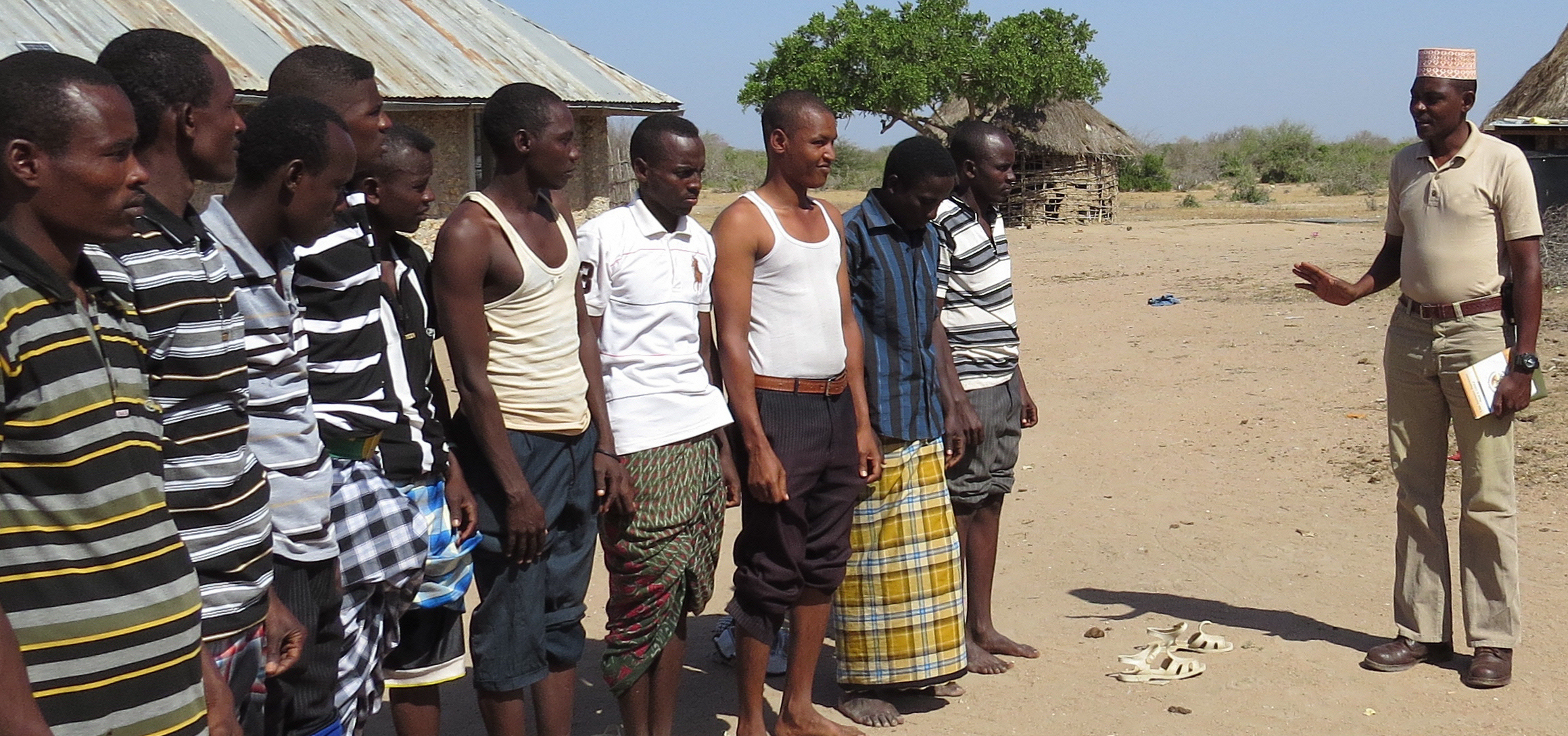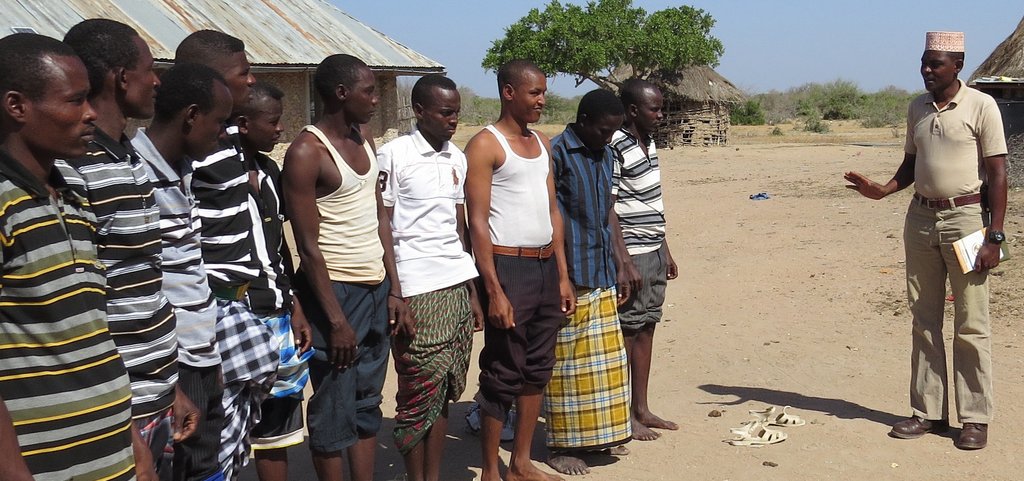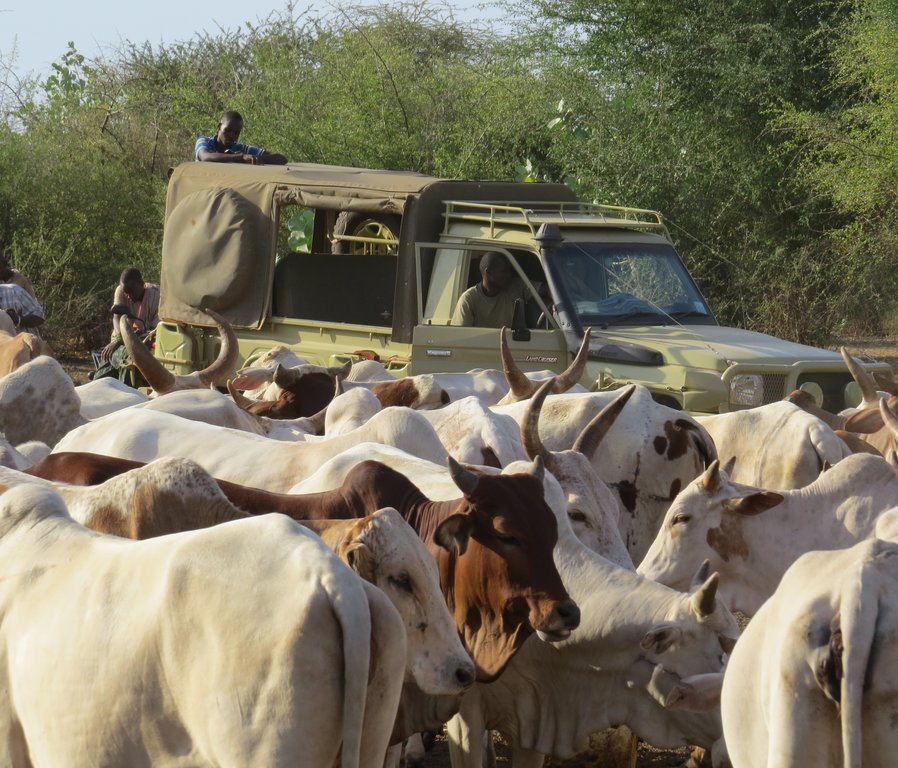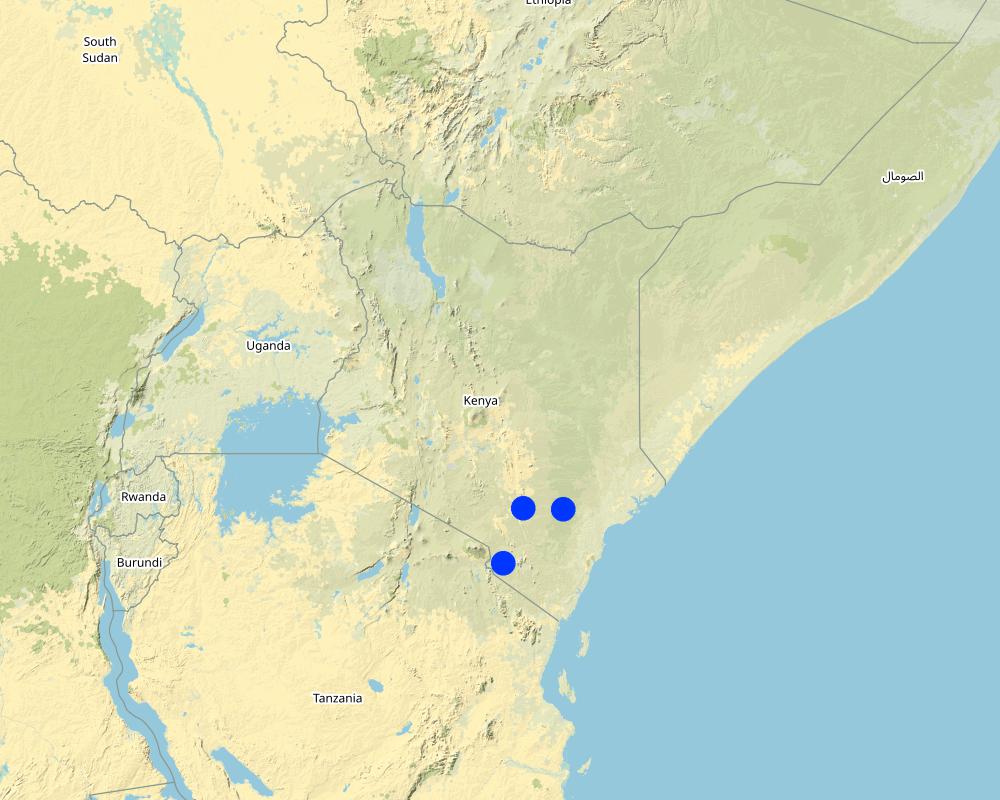Stabilization Through Conservation ('StabilCon') approach [Quênia]
- Criação:
- Atualização:
- Compilador/a: Harry Wells
- Editor: –
- Revisores: Donia Mühlematter, Hanspeter Liniger, Rima Mekdaschi Studer, Joana Eichenberger
approaches_3615 - Quênia
Veja as seções
Expandir tudo Recolher tudo1. Informação geral
1.2 Detalhes do contato das pessoas capacitadas e instituições envolvidas na avaliação e documentação da abordagem
Pessoa(s) capacitada(s)
Protected Area Manager:
Nome do projeto que facilitou a documentação/avaliação da Abordagem (se relevante)
Book project: Guidelines to Rangeland Management in Sub-Saharan Africa (Rangeland Management)1.3 Condições em relação ao uso da informação documentada através de WOCAT
Quando os dados foram compilados (no campo)?
16/04/2018
O/a compilador/a e a(s) pessoa(s) capacitada(s) aceitam as condições relativas ao uso de dados documentados através da WOCAT:
Sim
2. Descrição da abordagem de GST
2.1 Descrição curta da abordagem
The 'StabilCon' approach is a non-aggressive, low-intensity stabilization model that seeks to reconcile the needs of both humans and their natural environment. To achieve this, StabilCon aims to co-develop two mutually beneficial elements: sustainable natural resource management and human security in rural areas.
2.2 Descrição detalhada da abordagem
Descrição detalhada da abordagem:
StabilCon is a holistic approach that seeks to develop social-ecosystems that accept wildlife and respect natural resources, in order to address complex conservation challenges. Implemented by rural communities, in partnership with local stewardship organizations, such as Tsavo Conservation Group, StabilCon aims to build human and natural resource security. StabilCon also aims to shift the human-wildlife relationship from conflict towards a symbiotic relationship with mutual benefits. The approach is based on the premise that unstable environments (whether due to human, economic or environmental factors) preclude any conservation, sustainable development or natural resource management initiative. Therefore, StabilCon seeks to build institutional capacity in rural communities to achieve four interrelated goals: 1) Support the rule of law (e.g. through training of community rangers) to reduce physical insecurity for humans, wildlife and natural resources to manageable levels as a mandatory first step; 2) Use this security as a foundation on which to build and diversify nature-based economic opportunities (e.g. reduced wildlife poaching facilitates the development of tourism-based economic opportunities, while greater local security can also benefit livestock-keeping by reducing the incidents of stock thefts); 3) Strengthen environmental security to enable benefits of biodiversity conservation and healthy ecosystems to be shared by current and future generations; 4) Develop more robust, equitable and representative community governance system, aligned with county and national government agencies and their objectives (e.g. through governance training within rural communities).
StabilCon aims to use these four interrelated goals to develop a foundation of long-term environmental security and create circumstances conducive to socio-economic progress of rural communities. Activities are conducted by the StabilCon Implementation Unit (SIU), which in the Tsavo Model is composed of 5 members: 1) CEO & co-founder of Tsavo Conservation Group (TsavoCon) - responsibilities include managing TsavoCon's strategic direction through StabilCon, developing & managing strategic relationships, working with Kenya's national and county governments and US government, international fund raising; 2) TsavoCon Chief Financial Officer - Taita Taveta born and a member of the Association of Chartered Accountants (London) who leads human resources issues and is responsible for financial operations (e.g. opening bank accounts for full time staff, introducing and managing accounting software); 3) Operations Officer - supports CEO in developing strategic relationships (e.g. liaison with Taita Conservancy elders, county government officials, NGO partners) and is a Geographic Information System analyst developing a map database (e.g. elephant poaching data); 4) Liaison Officer - responsible for engagement with Orma community members of Malkahalaku Community Conservancy as well as liaison with local and national government officials, and to manage the conservancy's rangers (he was formerly an instructor with the Kenya Wildlife Service); 5) TsavoCon Pilot - responsibilities include managing aerial observation operations, TsavoCon vehicles, communications, resupply & logistics of TsavoCon assets in the field.
2.3 Fotos da abordagem
2.5 País/região/locais onde a abordagem foi aplicada
País:
Quênia
Especificação adicional de localização:
Greater Tsavo Ecosystem
Comentários:
For more details see: http://www.tsavocon.org/
Map
×2.6 Datas de início e término da abordagem
Indique o ano de início:
2016
Caso o ano exato seja desconhecido, indique a data aproximada de início da abordagem:
menos de 10 anos atrás (recentemente)
2.7 Tipo de abordagem
- Iniciativa/inovação local recente
2.8 Principais metas/objetivos da abordagem
StabilCon seeks to build institutional capacity in rural communities to achieve four interrelated goals:
1) Effective security, law and order - Support the rule of law to reduce physical insecurity for humans, wildlife and natural resources to manageable levels as a mandatory first step to enable the other three goals;
2) Economic security - Use this security as a foundation on which to build and diversify nature-based economic opportunities (e.g. livestock and tourism);
3) Environmental security - Strengthen environmental security to enable benefits of biodiversity conservation and healthy ecosystems to be shared by current and future generations;
4) Social security - Develop more robust, equitable and representative community governance system, aligned with county and national government agencies and their objectives.
2.9 Condição que propiciam ou inibem a implementação de tecnologia/tecnologias aplicada(s) segundo a abordagem
Normas e valores sociais/culturais/religiosos
- Propício
Livestock, water and security are already top priorities for local communities and are in alignment with StabilCon's objectives.
- Inibitivo
Rural communities, limited in their access to education, find it difficult to navigate the bureaucratic processes involved in securing funding.
Disponibilidade/acesso a recursos e serviços financeiros
- Propício
USAID and other donors assist greatly by funding StabilCon's activities.
Colaboração/coordenção de atores
- Propício
The improved relationship between the Malkahalaku community and the Kenya Wildlife Service (national government), facilitated by StabilCon's Implementation Unit (SIU), has been beneficial particularly in conflict mitigation.
- Inibitivo
Dysfunctional relationships among local chiefs and between Malkahalau community and the Kenya Wildlife Service (KWS) were initially hindering. In addition, almost every year, heightened competition over fodder/water for livestock between pastoralists and agriculturalists and between neighbouring pastoral communities lead to conflicts, which are often violent. Previously, the dysfunctional relationship between Malkahalaku community and KWS led to confrontations and destruction of KWS infrastructure. On one occasion, KWS rangers posted in the community were chased out by community members and the KWS ranger post burnt down by community members.
Quadro jurídico (posse de terra, direitos de uso da terra e da água)
- Propício
The official conservancy status given when the Malkahalaku Community Conservancy was established in 2015 was crucial in providing land tenure security. This stronger land tenure security has been instrumental in NRM through resolving conflicts with neighbouring communities over access to grazing/water.
Políticas
- Propício
The Wildlife Act has been particularly beneficial through its support of conservation activities. The Act emphasises effective public participation in the management of wildlife resources, thereby setting a basis for the strengthening of community based NRM.
Governança da terra (tomada de decisões, implementação e aplicação)
- Inibitivo
Poor law enforcement in rural areas leads to social insecurity at the community level. This impacts many aspects of NRM including illegal wildlife poaching and armed conflicts between pastoralist groups over access to grazing/water.
Conhecimento sobre GST, acesso a suporte técnico
- Propício
StabilCon aims to integrate the extensive local knowledge relating to pastoralism among Oromo people. However, traditional livestock management practices are also evolving and the Oromo are moving towards reducing livestock numbers and raising livestock quality (similar to the ranching approach).
- Inibitivo
Some previous local pastoral practices are no longer applicable to the changing environment, particularly with regard to quality and number of livestock, but practices are changing. For example, the shift from emphasis on the number of livestock owned towards smaller herd sizes and higher quality livestock.
Mercados (para comprar entradas, vender produtos) e preços
- Inibitivo
Importing meat from neighbouring countries (e.g. Tanzania, Uganda) floods Kenya's market, leading to a poor economic environment for local livestock production. StabilCon is currently planning to improve Malkahalaku Community Conservancy's access to national beef markets that will provide more favourable prices for the community's members.
Carga de trabalho, disponibilidade de força de trabalho
- Inibitivo
StabilCon has a small team, but their dedication helps compensate for the limited man hours.
Outro
- Inibitivo
Social insecurity is one of the main barriers and it is exacerbated by climatic changes. More specifically, shifts in patterns and temporal distribution of rainfall pose challenges even for highly mobile pastoralists. During drought periods, heightened competition over grazing and water intensify human conflict. These conflicts over basic resources preclude NRM activities.
3. Participação e papel das partes interessadas envolvidas
3.1 Partes interessadas envolvidas na abordagem e seus papéis
- Usuários de terra/comunidades locais
Taita Taveta Wildlife Conservancies Association and Malkahalaku Community Conservancy.
In the Taita area, Taita Taveta Wildlife Conservancies Association is the main local institutional actor, as it represents all 28 conservancies in the area (a large number of community members sign up to be part of one or more conservancies). In the Tana River County area, Malkahalaku Community Conservancy is the main institutional actor.
- Especialistas em GST/ consultor agrícola
Tsavo Conservation Group (TsavoCon). TsavoCon is composed of four members: CEO (an experienced protected area manager and leader of international relations; degree in Wildlife Conservation Management), Tana River County Coordinator (paramilitary-trained with experienced in wildlife conservation/anti-poaching; diploma in Wildlife Sanctuary Management), Taita Taveta County Coordinator (experienced wildlife conservationist and former CEO of Taita Taveta Wildlife Conservancies), Chief Financial Officer (experienced in conservation-focused non-profit management).
In the Tsavo Model of StabilCon, TsavoCon is the main facilitating organization, providing a link between local communities, livestock and rangeland management experts and international funding organisations. TsavoCon acts as the StabilCon Implementation Unit (SIU) in the Greater Tsavo Ecosystem.
- Pesquisadores
Geographic Information System specialist.
This researcher compiles data collected by StabilCon on poaching and insecurity. Tracking trends in elephant poaching as an indicator of increased security is one of the ways in which these data are used.
- Organização não governamental
Global Environmental Facility, African Wildlife Foundation, Wildlife Works.
These NGO's fund StabilCon's activities and/or act as conservation partners of Tsavo Conservation Group.
- Governo local
These include: the county environmental minister and their department; the county minister of lands; the county minister of livestock; the chairman of conservation compensation committee.
These actors are involved in allocation of local government support for community-level projects.
- Governo nacional (planejadores, responsáveis pelas decisões)
Kenya Wildlife Service (KWS), County Security Committee (national security apparatus)
These actors are mandated national security agencies. KWS's Law Enforcement Academy trained 22 members of Malkahalaku Community Conservancy (funded by Tsavo Conservation Group), who are now rangers for the conservancy. These rangers patrol their conservancy, increasing human security and reducing poaching. During droughts, KWS allow Malkahalaku Community Conservancy livestock to graze in Tsavo East National Park to relieve pressure on the community and diffuse conflicts over fodder/water. In Kenya, this is a relatively common but controversial practice as it puts pressure on the land within the protected area and potentially increases herd sizes and overall grazing pressure, particularly over the long term.
- Organização internacional
USAID, Global Environment Facility, African Wildlife Foundation, Wildlife Works
Funding and/or Tsavo Conservation Group conservation partners.
Caso várias partes interessadas foram envolvidas, indique a agência líder:
In the Tsavo model of StabilCon, Tsavo Conservation Group fulfils the role of StabilCon Implementation Unit (SIU), and is the lead facilitator and coordinator in the Greater Tsavo Ecosystem.
3.2 Envolvimento do usuários de terra/comunidades locais nas diferentes fases da abordagem
| Envolvimento do usuários de terra/comunidades locais | Especifique quem estava envolvido e descreva as atividades | |
|---|---|---|
| Iniciação/motivação | Participativo | Under the StabilCon approach, international and local actors are involved in the initiation phase but it leads towards self mobilization. |
| Planejamento | Participativo | The StabilCon Implementation Unit (composed of a coordinator, experts/professionals and local actors) leads the planning phase, which includes an area identification and a ground feasibility study. |
| Implementação | Automobilização | All activities are implemented by local communities. |
| Monitoramento/avaliação | Apoio externo | Data is mainly collected and analyzed by specialists/experts. |
3.3 Fluxograma (se disponível)
3.4 Decisão sobre a seleção de tecnologia/tecnologias de GST
Especifique quem decidiu sobre a seleção de tecnologia/tecnologias a serem implementadas:
- Principalmente usuários da terra, apoiados por especialistas em GST
Explique:
StabilCon aims to bring together international SLM experience with local SLM knowledge to develop activities.
Especifique em que base foram tomadas as decisões:
- Avaliação de conhecimento bem documentado de GST (tomada de decisão baseada em evidências)
- Experiência pessoal e opiniões (não documentado)
4. Suporte técnico, reforço das capacidades e gestão do conhecimento
4.1 Reforço das capacidades/ formação
Foi oferecida formação aos usuários da terra/outras partes interessadas?
Sim
Especifique quem foi capacitado:
- Usuários de terra
- local government (e.g. accounting, legal, economic)
Tipo de formação:
- Em exercício
- Cursos
Assuntos abordados:
22 members of the Malkahalaku Community Conservancy were trained through a Kenya Wildlife Service Law Enforcement Academy programme, to enable them to serve as rangers for their conservancy to improve local security. The StabilCon implementation Unit also conducted courses to train the Conservancy's management and employees in various offices (e.g. accounting, legal, economic) to improve governance in Malkahalaku Community Conservancy.
4.2 Serviço de consultoria
Os usuários de terra têm acesso a um serviço de consultoria?
Sim
- Depends on who is receiving the advice.
Descreva/comentários:
StabilCon Implementation Unit (SIU) provides advice to individuals at multiple levels from government to local.
4.3 Fortalecimento da instituição (desenvolvimento organizacional)
As instituições foram fortalecidas ou estabelecidas através da abordagem?
- Sim, significativamente
Especifique a que nível (níveis) as instituições foram fortalecidas ou estabelecidas:
- Local
- Regional
- Nacional
Descreva instituição, papéis e responsabilidades, membros, etc.
Tsavo Conservation Group, as the StabilCon Implementation Unit (SIU), liaise with all stakeholders to develop an integrated landscape security model in Taita
Especifique o tipo de apoio:
- Financeiro
- Reforço das capacidades/ formação
Dê mais detalhes:
The Kenya Wildlife Service is due to train 40 Taita community rangers at their Law Enforcement Academy, funded by USAID in conjunction with Tsavo Conservation Group.
4.4 Monitoramento e avaliação
Monitoramento e avaliação são partes da abordagem?
Não
Comentários:
The StabilCon approach relies on accurate data to inform decision making. Tsavo Conservation Group maintains a rigorous monitoring and evaluation procedure and maps human-wildlife conflict and rural human dynamics affecting the natural environment in its focal area.
4.5 Pesquisa
A pesquisa foi parte da abordagem?
Não
5. Financiamento e apoio material externo
5.1 Orçamento anual para o componente de GST da abordagem
Caso o orçamento exato seja desconhecido, indique a faixa:
- 100.000-1.000.000
Comentários (p. ex. principais fontes de recursos/principais doadores):
USAID and private donors are the main funding sources.
5.2 Apoio financeiro/material concedido aos usuários da terra
Os usuários da terra receberam apoio financeiro/material para a implementação de tecnologia/tecnologias?
Sim
Caso afirmativo, especifique tipo(s) de apoio, condições e fornecedor(es):
Tsavo Conservation Group raises external funding for rangers (training, salaries etc.), security infrastructure (buildings, vehicles etc.); logistics, planning and deployment costs. However, the StabilCon approach aims to make all activities economically self-sustaining through internal funding.
5.3 Subsídios para entradas específicas (incluindo mão-de-obra)
- Nenhum
Se a mão-de-obra pelos usuários da terra foi uma entrada substancial, isso foi:
- Pago em dinheiro
Comentários:
Conservancy rangers are paid in cash through StabilCon, but these costs will gradually be internalized.
5.4 Crédito
Foi concedido crédito segundo a abordagem para atividades de GST?
Não
5.5 Outros incentivos ou instrumentos
Foram utilizados outros incentivos ou instrumentos para promover a implementação das tecnologias de GST?
Não
6. Análise de impactos e declarações finais
6.1 Impactos da abordagem
A abordagem concedeu autonomia aos usuários locais de terra, melhorou a participação das partes interessadas?
- Não
- Sim, pouco
- Sim, moderadamente
- Sim, significativamente
The training of community conservancy rangers enables the conservancies to increase the degree to which they manage their own security, and are less dependent on already overstretched government law enforcement agencies.
A abordagem auxiliou os usuários da terra a implementar e manter as tecnologias de GST?
- Não
- Sim, pouco
- Sim, moderadamente
- Sim, significativamente
Data collected thus far indicates that elephant poaching has declined considerably since StabilCon's implementation, but it is not yet possible to gauge the sustainability due to the short duration of operation.
A abordagem melhorou a coordenação e a implementação economicamente eficiente da GST?
- Não
- Sim, pouco
- Sim, moderadamente
- Sim, significativamente
By acting as an impartial arbitrator, the StabilCon Implementation Unit facilitated coordination between chiefs who previously had dysfunctional relationships.
A abordagem mobilizou/melhorou o acesso aos recursos financeiros para implementação da GST?
- Não
- Sim, pouco
- Sim, moderadamente
- Sim, significativamente
StabilCon raised funding from international organizations such as USAID, that would otherwise have been inaccessible to local people.
A abordagem aprimorou o conhecimento e as capacidades de outras partes interessadas?
- Não
- Sim, pouco
- Sim, moderadamente
- Sim, significativamente
Capacity building was provided to local government employees (e.g. accountants, legal, economic). It was also provided to conservancy members in the form of ranger training.
A abordagem construiu/fortaleceu instituições, colaboração entre partes interessadas?
- Não
- Sim, pouco
- Sim, moderadamente
- Sim, significativamente
StabilCon facilitated collaboration among actors who previously did not coordinate at local-level (chiefs) and government-level (government departments).
A abordagem atenuou conflitos?
- Não
- Sim, pouco
- Sim, moderadamente
- Sim, significativamente
The StabilCon Implementation Unit helped mitigate conflicts between Malkahalaku Community members and the Kenya Wildlife Service (national government) by facilitating dialogue and acting as third party mediators.
A abordagem resultou em uso/fontes de energia mais sustentável?
- Não
- Sim, pouco
- Sim, moderadamente
- Sim, significativamente
No energy source dimension to the approach.
A abordagem aprimorou a capacidade dos usuários da terra de adaptar-se a mudanças climáticas/extremos e atenuar os desastres relacionados com o clima?
- Não
- Sim, pouco
- Sim, moderadamente
- Sim, significativamente
As StabilCon has only been active for 3 years this is difficult to judge.
A abordagem resultou em emprego, oportunidades de renda?
- Não
- Sim, pouco
- Sim, moderadamente
- Sim, significativamente
StabilCon created job opportunities relating to conservancy security (mainly rangers).
6.2 Principal motivação dos usuários da terra para implementar a GST
- Lucro (lucrabilidade) aumentado, melhora da relação custo-benefício
Wealth and a better life are the main motivations for all activities.
- normas e regulamentos (multas)/aplicação
Law enforcement at the community level in rural communities is one of the main benefits of formally trained conservancy rangers.
- Atenuação de conflitos
Conflict mitigation is a significant aspect of this approach. The presence of formally trained rangers benefits community members in the form of improved social security and possibly economic opportunities (e.g. less wildlife poaching may improve tourism and fewer stock thefts may facilitate livestock-keeping).
6.3 Atividades de sustentabilidade de abordagem
Os usuários da terra podem manter o que foi implementado através da abordagem (sem apoio externo)?
- Incerto
Caso negativo ou incerto, especifique e comente:
StabilCon has only been active for 3 years so this is difficult to gauge.
6.4 Pontos fortes/vantagens da abordagem
| Pontos fortes/vantagens/oportunidades na visão do usuário da terra |
|---|
| Due to StabilCon's structured approach, it can be budgeted in the long term. |
| StabilCon requires minimal intervention and relies mainly on internal motivation and activity. |
| The long-term aim is for revenue to be generated internally and sustainably through a structured investment model. |
| Pontos fortes/vantagens/oportunidades na visão do/a compilador/a ou de outra pessoa capacitada |
|---|
| Enables local communities to access international funds. |
| The StabilCon approach seeks to leverage the interaction between SLM and human security. |
| Integration of international SLM experience with local knowledge. |
| The StabilCon approach seeks to identify the extraordinary in people and nurture their strengths |
6.5 Pontos fracos, desvantagens da tecnologia e formas de superá-los
| Pontos fracos/desvantagens/riscos na visão do usuário da terra | Como eles podem ser superados? |
|---|---|
| The need to raise start-up funding. | Ensure adequate focus on fund-raising. |
| StabilCon is not a stand-alone 'silver bullet', but needs a certain amount of national infrastructure in place in order to operate. | None. |
| StabilCon depends heavily on the individuals employed and can thus be impacted considerably by the human weaknesses of individuals. | Over the long-term, educate people to develop interdisciplinary skills. |
| Pontos fracos/vantagens/riscos na visão do/a compilador/a ou de outra pessoa capacitada | Como eles podem ser superados? |
|---|---|
| With few years of active experience of StabilCon, the benefits, downfalls and sustainability of the approach are still unclear. | Continuation of the approach will reveal its strengths and weaknesses. |
7. Referências e links
7.1 Métodos/fontes de informação
- entrevistas com especialistas em GST
One expert (co-founder & CEO of Tsavo Conservation Group and the StabilCon approach)
- compilação de relatórios e outra documentação existente
Reports and documentation shared by the informant and project websites.
7.2 Referências às publicações disponíveis
Título, autor, ano, ISBN:
Saunders I, Saunders T (2017) The StabilCon Brief
Disponível de onde? Custos?
Freely available an in the public domain
7.3 Links para informação relevante que está disponível online
Título/ descrição:
Stabilization Through Conservation (StabilCon) on Tsavo Conservation Group website
URL:
http://www.tsavocon.org/stabilcon/
Título/ descrição:
Tsavo Conservation Group's eMAP (Elephant Monitoring and Anti-Poaching) project
Links e módulos
Expandir tudo Recolher tudoLinks
Não há links
Módulos
Não há módulos






